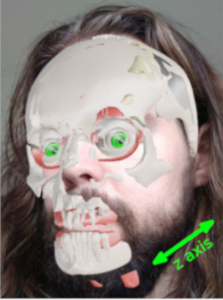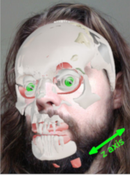Information
- Publication Type: Master Thesis
- Workgroup(s)/Project(s):
- Date: March 2020
- Date (Start): 5. June 2019
- Date (End): 5. March 2020
- TU Wien Library:
- Diploma Examination: 25. March 2020
- Open Access: yes
- First Supervisor:
Abstract
The purpose of this master thesis is the development of a mobile, anatomical educationapplication for the general public, which shifts the passive, unthoughtful mobile deviceusage to a more active, teaching usage by utilizing macroscopic and regional anatomy. The new, immersive learning experience with interactive, Three Dimensional (3D), Aug-mented Reality (AR) anatomy models synchronizes the models in realtime with the user’sface. Individuals of the general public can digitally dissect their own facial anatomy tolearn geometrical, spatial, and textual anatomy features.Immanent features of the created learning process are self-directed anatomy learning,less cognitive load, a motivation-, attention-, concentration increase, longer preserved sat-isfaction, new anatomical knowledge, and better spatial abilities compared to traditionallearning. The high complexity of the human anatomy restricts the synchronized anatomymodels to the head. Notwithstanding, all human anatomy models can be viewed as TwoDimensional (2D) or AR 3D renderings, whereby only the head anatomy is synchronizedwith the user’s head. The answered research questions are “How can interactive AR be used in anatomicaleducation for the general public?” and “How much and what anatomy can be learned inwhich time with the developed application compared to state of the art works?”. HeadPose Estimation (HPE) links AR managed by the framework ARCore with 3D anatomymodels from Body Parts 3D (BP3D) and anatomy information from FoundationalModel of Anatomy (FMA) to educate the general public in anatomy. Recommended requirements from professional literature are fulfilled by the developed mobile application named ARnatomy, which is a jointed, anatomical, interactive learning experience. The development result has been evaluated in an informal study with eight participants, whichshowed that mobile AR can be used for the anatomical education of the general public.Seven of eight participants gained anatomical knowledge in a geometrical, spatial, and textual form.
Additional Files and Images
Additional images and videos
Additional files
Weblinks
No further information available.
BibTeX
@mastersthesis{Schrempf_2020,
title = " Fantastic Voyage: An AugmentedReality Approach to
AnatomicalEducation for the General Public",
author = "Manuel Schrempf",
year = "2020",
abstract = "The purpose of this master thesis is the development of a
mobile, anatomical educationapplication for the general
public, which shifts the passive, unthoughtful mobile
deviceusage to a more active, teaching usage by utilizing
macroscopic and regional anatomy. The new, immersive
learning experience with interactive, Three Dimensional
(3D), Aug-mented Reality (AR) anatomy models synchronizes
the models in realtime with the user’sface. Individuals of
the general public can digitally dissect their own facial
anatomy tolearn geometrical, spatial, and textual anatomy
features.Immanent features of the created learning process
are self-directed anatomy learning,less cognitive load, a
motivation-, attention-, concentration increase, longer
preserved sat-isfaction, new anatomical knowledge, and
better spatial abilities compared to traditionallearning.
The high complexity of the human anatomy restricts the
synchronized anatomymodels to the head. Notwithstanding, all
human anatomy models can be viewed as TwoDimensional (2D) or
AR 3D renderings, whereby only the head anatomy is
synchronizedwith the user’s head. The answered research
questions are “How can interactive AR be used in
anatomicaleducation for the general public?” and “How
much and what anatomy can be learned inwhich time with the
developed application compared to state of the art
works?”. HeadPose Estimation (HPE) links AR managed by the
framework ARCore with 3D anatomymodels from Body Parts 3D
(BP3D) and anatomy information from FoundationalModel of
Anatomy (FMA) to educate the general public in anatomy.
Recommended requirements from professional literature are
fulfilled by the developed mobile application named
ARnatomy, which is a jointed, anatomical, interactive
learning experience. The development result has been
evaluated in an informal study with eight participants,
whichshowed that mobile AR can be used for the anatomical
education of the general public.Seven of eight participants
gained anatomical knowledge in a geometrical, spatial, and
textual form.",
month = mar,
address = "Favoritenstrasse 9-11/E193-02, A-1040 Vienna, Austria",
school = "Research Unit of Computer Graphics, Institute of Visual
Computing and Human-Centered Technology, Faculty of
Informatics, TU Wien",
URL = "https://www.cg.tuwien.ac.at/research/publications/2020/Schrempf_2020/",
}

 image
image Master Thesis
Master Thesis Poster
Poster


